Base plaatontwerp voorbeeld met behulp van AISC 360-22 en ACI 318-19
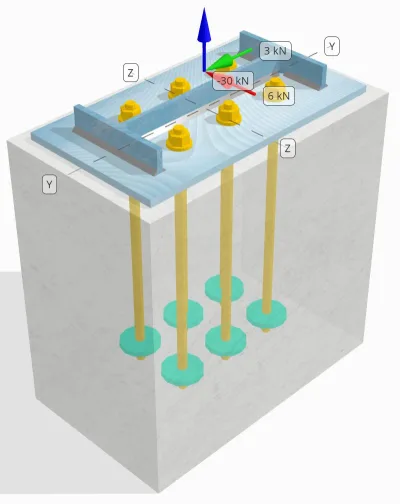
Probleemverklaring
Determine whether the designed column-to-base plate connection is sufficient for 30 kN tension load, 3 kN Vy shear load, en 6 kN Vz schuifbelasting.
Gegeven gegevens
Kolom:
Kolomgedeelte: W14x30
Kolomgebied: 5709.7 mm2
Kolommateriaal: A992
Bodemplaat:
Baseplaat afmetingen: 250 mm x 250 mm
Basisplaatdikte: 12 mm
Basisplaatmateriaal: A992
Vocht:
Voegdikte: 0 mm
Beton:
Concrete dimensies: 300 mm x 500 mm
Betonnen dikte: 500 mm
Betonnen materiaal: 20.7 MPa
Gebarsten of ongescheurd: Gebarsten
Ankers:
Ankerdiameter: 16 mm
Effectieve inbeddingslengte: 400 mm
Anker einde: Circular Plate
Ingebouwde plaatdiameter: 70 mm
Ingebedde plaatdikte: 10 mm
Steel Material: F1554 Gr.55
Threads in Shear Plane: Included
Lassen:
Lasgrootte: 7 mm
Vulmetaalclassificatie: E70XX
Ankergegevens (van Skyciv Calculator):
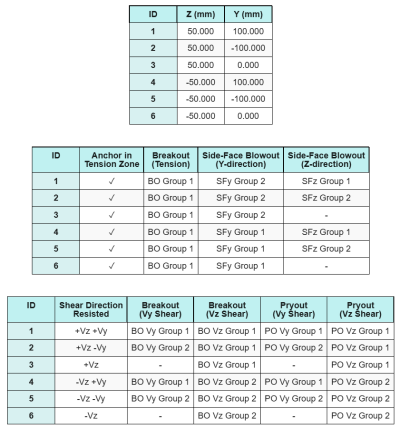
Model in SkyCiv Gratis tool
Modelleer vandaag nog het ontwerp van de basisplaat hierboven met onze gratis online tool! Geen aanmelding vereist.
Notitie
Het doel van dit ontwerpvoorbeeld is om de stapsgewijze berekeningen te demonstreren voor capaciteitscontroles met gelijktijdige schuif- en axiale belastingen. Een aantal van de vereiste controles zijn al besproken in de voorgaande ontwerpvoorbeelden. Raadpleeg de links in elke sectie.
Stapsgewijze berekeningen
Controleren #1: Lascapaciteit berekenen
To determine the weld capacity under simultaneous loading, we first need to calculate the weld demand due to the shear load and the weld demand due to the tension load. You may refer to this link for the procedure to obtain the weld demands for shear, and this link for the tension weld demands.
For this design, de weld demand at the web due to the tension load is found to be as follows, where the stress is expressed as kracht per lengte-eenheid.
\(R_{u,\tekst{web}} = frac{T_{u,\tekst{anker}}}{l_{\tekst{eff}}} = frac{5\ \tekst{kN}}{93.142\ \tekst{mm}} = 0.053681\ \tekst{kN / mm}\)
Verder, de weld stress at any part of the column section due to the shear load is determined as:
\(v_{uy} = frac{V_y}{L_{\tekst{lassen}}} = frac{3\ \tekst{kN}}{1250.7\ \tekst{mm}} = 0.0023987\ \tekst{kN / mm}\)
\(v_{naar} = frac{V_z}{L_{\tekst{lassen}}} = frac{6\ \tekst{kN}}{1250.7\ \tekst{mm}} = 0.0047973\ \tekst{kN / mm}\)
Since there is a combination of tension and shear loads at the web, we need to obtain the resultant. Expressing this as force per unit length, wij hebben:
\(r_u = sqrt{(R_{u,\tekst{web}})^ 2 + (v_{uy})^ 2 + (v_{naar})^ 2}\)
\(r_u = sqrt{(0.053681\ \tekst{kN / mm})^ 2 + (0.0023987\ \tekst{kN / mm})^ 2 + (0.0047973\ \tekst{kN / mm})^ 2}\)
\(r_u = 0.053949\ \tekst{kN / mm}\)
Voor de flenzen, only shear stresses are present. Dus, the resultant is:
\(r_u = sqrt{(v_{uy})^ 2 + (v_{naar})^ 2}\)
\(r_u = sqrt{(0.0023987\ \tekst{kN / mm})^ 2 + (0.0047973\ \tekst{kN / mm})^ 2} = 0.0053636\ \tekst{kN / mm}\)
De volgende, we berekenen de weld capacities. For the flange, we determine the angle θ de ... gebruiken Vz en Vy belastingen.
\( \theta = \tan^{-1}\!\links(\frac{v_{uy}}{v_{naar}}\Rechtsaf) = tan^{-1}\!\links(\frac{0.0023987\ \tekst{kN / mm}}{0.0047973\ \tekst{kN / mm}}\Rechtsaf) = 0.46365\ \tekst{rad} \)
bijgevolg, de kds factor and weld capacity are calculated using AISC 360-22 Eq. J2-5 en Eq. J2-4.
\(zodat ingenieurs precies kunnen nagaan hoe deze berekeningen zijn gemaakt{ds} = 1.0 + 0.5(\zonder(\theta))^{1.5} = 1 + 0.5 \keer (\zonder(0.46365\ \tekst{rad}))^{1.5} = 1.1495\)
\(\phi r_{n,flg} = \phi\,0.6\,F_{exx}\,E_w\,k_{ds} = 0.75 \keer 0.6 \keer 480\ \tekst{MPa} \keer 4.95\ \tekst{mm} \keer 1.1495 = 1.2291\ \tekst{kN / mm}\)
Voor het internet, we calculate the angle θ using a different formula. Let daar op Vuy is used in the formula since it represents the load parallel to the weld axis.
\( \theta = \cos^{-1}\!\links(\frac{v_{uy}}{r_u}\Rechtsaf) = \cos^{-1}\!\links(\frac{0.0023987\ \tekst{kN / mm}}{0.053949\ \tekst{kN / mm}}\Rechtsaf) = 1.5263\ \tekst{rad} \)
Gebruik makend van AISC 360-22 Eq. J2-5 en Eq. J2-4, de kds factor and the resulting weld capacity are determined in the same manner.
\(zodat ingenieurs precies kunnen nagaan hoe deze berekeningen zijn gemaakt{ds} = 1.0 + 0.5(\zonder(\theta))^{1.5} = 1 + 0.5 \keer (\zonder(1.5263\ \tekst{rad}))^{1.5} = 1.4993\)
\(\phi r_{n,web} = \phi\,0.6\,F_{exx}\,E_w\,k_{ds} = 0.75 \keer 0.6 \keer 480\ \tekst{MPa} \keer 4.95\ \tekst{mm} \keer 1.4993 = 1.603\ \tekst{kN / mm}\)
Ten slotte, we perform base metal checks for both the column and the base plate, then obtain the governing base metal capacity.
\( \phi r_{nbm,col} = \phi\,0.6\,F_{u,col}\,t_{col,half} = 0.75 \keer 0.6 \keer 448.2\ \tekst{MPa} \keer 3.429\ \tekst{mm} = 0.6916\ \tekst{kN / mm} \)
\( \phi r_{nbm,bp} = \phi\,0.6\,F_{u,bp}\,t_{bp} = 0.75 \keer 0.6 \keer 400\ \tekst{MPa} \keer 12\ \tekst{mm} = 2.1595\ \tekst{kN / mm} \)
\( \phi r_{nbm} = \min\big(\phi r_{nbm,bp},\ \phi r_{nbm,col}\big) = min(2.1595\ \tekst{kN / mm},\ 0.6916\ \tekst{kN / mm}) = 0.6916\ \tekst{kN / mm} \)
We then compare the fillet weld capacities en base metal capacities for the weld demands at the flanges and web separately.
Sinds 0.053949 kN / mm < 0.6916 kN / mm, De lascapaciteit is voldoende.
Controleren #2: Bereken de buigcapaciteit van de basisplaat als gevolg van spanningsbelasting
A design example for the base plate flexural yielding capacity is already discussed in the Base Plate Design Example for Tension. Voor de stapsgewijze berekening verwijzen wij u naar deze link.
Controleren #3: Bereken de trekcapaciteit van de ankerstaaf
A design example for the anchor rod tensile capacity is already discussed in the Base Plate Design Example for Tension. Voor de stapsgewijze berekening verwijzen wij u naar deze link. Voor de stapsgewijze berekening verwijzen wij u naar deze link.
Controleren #4: Bereken de betonuitbraakcapaciteit in spanning
A design example for the capacity of the concrete in tension breakout is already discussed in the Base Plate Design Example for Tension. Voor de stapsgewijze berekening verwijzen wij u naar deze link. Voor de stapsgewijze berekening verwijzen wij u naar deze link.
Controleren #5: Bereken het pull -outcapaciteit van het anker
A design example for the anchor pull out capacity is already discussed in the Base Plate Design Example for Tension. Voor de stapsgewijze berekening verwijzen wij u naar deze link. Voor de stapsgewijze berekening verwijzen wij u naar deze link.
Controleren #6: Bereken de buigcapaciteit van de instortplaat
A design example for the supplementary check on the embedded plate flexural yielding capacity is already discussed in the Base Plate Design Example for Tension. Voor de stapsgewijze berekening verwijzen wij u naar deze link.
Controleren #7: Bereken de side-face blowoutcapaciteit in Y-richting
Om de te berekenen Side-Face Blowout (SFBO) capaciteit, we first determine the total tension force on the anchors closest to the edge. For this check, we will evaluate the capacity of the edge along the Y-direction.
Since the failure cone projections of the SFBO along the Y-direction overlap, the anchors are treated as an ankergroep.
The total tension demand of the anchor group is calculated as:
\(N_{Doen} = links(\frac{N_x}{N_{een,t}}\Rechtsaf) N_{j,G1} = links(\frac{30\ \tekst{kN}}{6}\Rechtsaf) \keer 3 = 15\ \tekst{kN}\)
De volgende, We bepalen de randafstanden:
\(c_{z,\min} = min(c_{\tekst{links},G1},\ c_{\tekst{Rechtsaf},G1}) = min(100\ \tekst{mm},\ 200\ \tekst{mm}) = 100\ \tekst{mm}\)
\(c_{j,\min} = min(c_{\tekst{top},G1},\ c_{\tekst{bodem},G1}) = min(150\ \tekst{mm},\ 150\ \tekst{mm}) = 150\ \tekst{mm}\)
Using these edge distances, we berekenen de anchor group capacity in overeenstemming met ACI 318-19 Eq. (17.6.4.1).
\(N_{net zo} = links(\frac{1 + \dfrac{c_{j,\min}}{c_{z,\min}}}{4} + \frac{S_{som,j,G1}}{6\,c_{z,\min}}\Rechtsaf)\keer 13 \keer links(\frac{c_{z,\min}}{1\ \tekst{mm}}\Rechtsaf)\keer sqrt{\frac{EEN_{brg}}{\tekst{mm}^ 2}}\ \lambda_a sqrt{\frac{f_c}{\tekst{MPa}}}\keer 0.001\ \tekst{kN}\)
\(N_{net zo} = links(\frac{1 + \dfrac{150\ \tekst{mm}}{100\ \tekst{mm}}}{4} + \frac{200\ \tekst{mm}}{6\keer 100\ \tekst{mm}}\Rechtsaf)\keer 13 \keer links(\frac{100\ \tekst{mm}}{1\ \tekst{mm}}\Rechtsaf)\keer sqrt{\frac{3647.4\ \tekst{mm}^ 2}{1\ \tekst{mm}^ 2}}\keer 1 \keer sqrt{\frac{20.68\ \tekst{MPa}}{1\ \tekst{MPa}}}\keer 0.001\ \tekst{kN}\)
\(N_{net zo} = 342.16\ \tekst{kN}\)
In the original equation, a reduction factor is applied when the anchor spacing is less than 6ca₁, assuming the headed anchors have sufficient edge distance. Echter, in this design example, sinds ca₂ < 3ca₁, the SkyCiv calculator applies an additional reduction factor to account for the reduced edge capacity.
Uiteindelijk, de design SFBO capacity is:
\(\phi N_{net zo} = \phi\,N_{net zo} = 0.7 \keer 342.16\ \tekst{kN} = 239.51\ \tekst{kN}\)
Sinds 15 kN < 239.51 kN, the SFBO capacity along the Y-direction is voldoende.
Controleren #8: Bereken side-face blowoutcapaciteit in Z-richting
Following the same approach as in Controleren #7, the total tension demand of the anchor group for the anchors closest to the Z-direction edge is:
\(N_{Doen} = links(\frac{N_x}{N_{een,t}}\Rechtsaf)N_{z,G1} = links(\frac{30\ \tekst{kN}}{6}\Rechtsaf)\keer 2 = 10\ \tekst{kN}\)
De randafstanden are calculated as:
\(c_{j,\min} = min(c_{\tekst{top},G1},\ c_{\tekst{bodem},G1}) = min(150\ \tekst{mm},\ 350\ \tekst{mm}) = 150\ \tekst{mm}\)
\(c_{z,\min} = min(c_{\tekst{links},G1},\ c_{\tekst{Rechtsaf},G1}) = min(100\ \tekst{mm},\ 100\ \tekst{mm}) = 100\ \tekst{mm}\)
De nominal SFBO capacity is then determined as:
\(N_{net zo} = links(\frac{1 + \dfrac{c_{z,\min}}{c_{j,\min}}}{4} + \frac{S_{som,z,G1}}{6\,c_{j,\min}}\Rechtsaf)\keer 13 \keer links(\frac{c_{j,\min}}{1\ \tekst{mm}}\Rechtsaf)\keer sqrt{\frac{EEN_{brg}}{\tekst{mm}^ 2}}\ \lambda_a sqrt{\frac{f_c}{\tekst{MPa}}}\keer 0.001\ \tekst{kN}\)
\(N_{net zo} = links(\frac{1 + \dfrac{100\ \tekst{mm}}{150\ \tekst{mm}}}{4} + \frac{100\ \tekst{mm}}{6\keer 150\ \tekst{mm}}\Rechtsaf)\keer 13 \keer links(\frac{150\ \tekst{mm}}{1\ \tekst{mm}}\Rechtsaf)\keer sqrt{\frac{3647.4\ \tekst{mm}^ 2}{1\ \tekst{mm}^ 2}}\keer 1 \keer sqrt{\frac{20.68\ \tekst{MPa}}{1\ \tekst{MPa}}}\keer 0.001\ \tekst{kN}\)
\(N_{net zo} = 282.65\ \tekst{kN}\)
Since the edge distance ca₂ is still less than 3ca₁, the same modified reduction factor is applied.
Uiteindelijk, de design SFBO capacity is:
\(\phi N_{net zo} = \phi\,N_{net zo} = 0.7 \keer 282.65\ \tekst{kN} = 197.86\ \tekst{kN}\)
Sinds 10 kN < 197.86 kN, the SFBO capacity along the Z-direction is voldoende.
Controleren #9: Calculate breakout capacity (Vy afschuiving)
A design example for the concrete breakout capacity in Vy shear is already discussed in the Base Plate Design Example for Shear. Voor de stapsgewijze berekening verwijzen wij u naar deze link.
Controleren #10: Calculate breakout capacity (Vz-afschuiving)
A design example for the concrete breakout capacity in Vy shear is already discussed in the Base Plate Design Example for Shear. Voor de stapsgewijze berekening verwijzen wij u naar deze link.
Controleren #11: Calculate pryout capacity (Vy afschuiving)
A design example for the capacity of the concrete against pryout failure due to Vy shear is already discussed in the Base Plate Design Example for Shear. Voor de stapsgewijze berekening verwijzen wij u naar deze link.
Controleren #12: Calculate pryout capacity (Vz-afschuiving)
A design example for the capacity of the concrete against pryout failure due to Vy shear is already discussed in the Base Plate Design Example for Shear. Voor de stapsgewijze berekening verwijzen wij u naar deze link.
Controleren #13: Bereken de afschuifcapaciteit van de ankerstang
Een ontwerpvoorbeeld voor de afschuifcapaciteit van de ankerstang wordt al besproken in het ontwerpvoorbeeld van de basisplaat voor afschuiving. Voor de stapsgewijze berekening verwijzen wij u naar deze link.
Controleren #14: Calculate anchor rod shear and axial capacity (AISC)
To determine the capacity of the anchor rod under combined shear and axial loads, we gebruiken AISC 360-22 Eq. J3-3a. In this calculator, the equation is rearranged to express the result as the modified shear strength instead.
De shear demand wordt gedefinieerd als de shear load per anchor.
\(V_{Doen} = V_{Doen} = 2.5\ \tekst{kN}\)
De tension demand is expressed as the tensile stress in the anchor rod.
\(f_{ut} = frac{N_{Doen}}{EEN_{hengel}} = frac{5\ \tekst{kN}}{201.06\ \tekst{mm}^ 2} = 24.868\ \tekst{MPa}\)
De modified shear capacity of the anchor rod is then calculated as:
\(F'_{nv} = \min\!\links(1.3\,F_{nv} – \links(\frac{F_{nv}}{\phi F_{nt}}\Rechtsaf) f_{ut},\; F_{nv}\Rechtsaf)\)
\(F'_{nv} = \min\!\links(1.3\keer 232.69\ \tekst{MPa} – \links(\frac{232.69\ \tekst{MPa}}{0.75\keer 387.82\ \tekst{MPa}}\Rechtsaf)\keer 24.868\ \tekst{MPa},\; 232.69\ \tekst{MPa}\Rechtsaf) = 232.69\ \tekst{MPa}\)
We then multiply this strength by the anchor area gebruik makend van AISC 360-22 Eq. J3-2.
\(\phi R_{n,\tekst{aisc}} = phi F’_{nv} EEN_{\tekst{hengel}} = 0.75 \keer 232.69\ \tekst{MPa} \keer 201.06\ \tekst{mm}➔⡔ Koop generieke tadalafil 35.09\ \tekst{kN}\)
Sinds 2.5 kN < 35.09 kN, the anchor rod capacity is voldoende.
Controleren #15: Calculate interaction checks (ACI)
When checking the anchor rod capacity under combined shear and tension loads using ACI, a different approach is applied. For completeness, we also perform the ACI interaction checks in this calculation, which include other concrete interaction checks ook.
Here are the resulting ratios for all ACI tension checks:
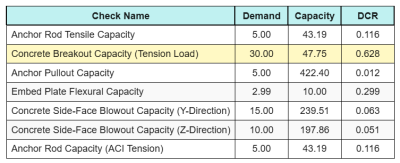
And here are the resulting ratios for all ACI shear checks:
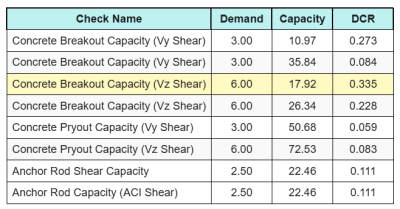
We get the check with the largest ratio and compare it to the maximum interaction ratio using ACI 318-19 Eq. 17.8.3.
\(IK_{int} = frac{N_{Doen}}{\phi N_n} + \frac{V_{Doen}}{\phi V_n} = frac{30}{47.749} + \frac{6}{17.921} = 0.96308\)
Sinds 0.96 < 1.2, the interaction check is voldoende.
Ontwerp Samenvatting
De Skyciv Base Plate Design Software Kan automatisch een stapsgewijze berekeningsrapport genereren voor dit ontwerpvoorbeeld. Het biedt ook een samenvatting van de uitgevoerde controles en hun resulterende verhoudingen, De informatie in één oogopslag gemakkelijk te begrijpen maken. Hieronder is een sample samenvattende tabel, die is opgenomen in het rapport.
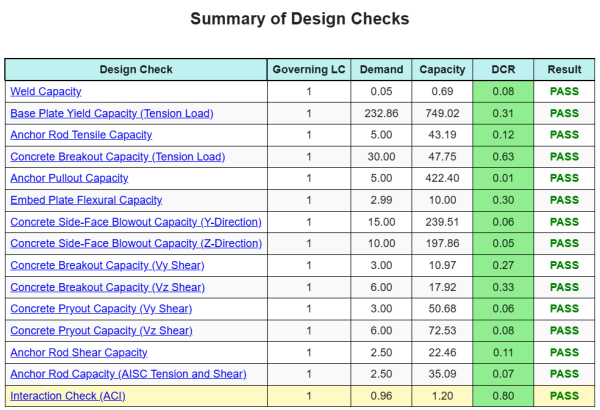
Skyciv Sample Report
Bekijk het detailniveau en de duidelijkheid die u kunt verwachten van een SkyCiv-basisplaatontwerprapport. Het rapport bevat alle belangrijke ontwerpcontroles, vergelijkingen, en resultaten gepresenteerd in een duidelijk en gemakkelijk leesbaar formaat. Het voldoet volledig aan de ontwerpnormen. Klik hieronder om een voorbeeldrapport te bekijken dat is gegenereerd met de SkyCiv-basisplaatcalculator.
Koop baseplaatsoftware
Koop de volledige versie van de basisplaatontwerpmodule op zichzelf zonder andere SkyCiv -modules. Dit geeft u een volledige set resultaten voor het ontwerp van de basisplaat, inclusief gedetailleerde rapporten en meer functionaliteit.


